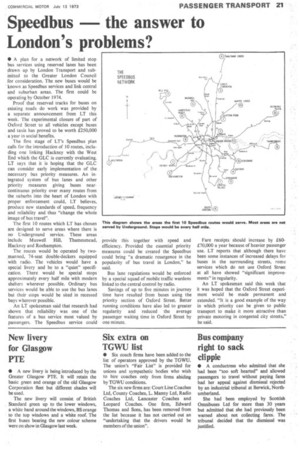Speedbus the answer to London's problems?
Page 23

If you've noticed an error in this article please click here to report it so we can fix it.
• A plan for a network of limited stop bus services using reserved lanes has been drawn up by London Transport and submitted to the Greater London Council for consideration. The new buses would be known as Speedbus services and link central and suburban areas. The first could be operating by October 1974.
Proof that reserved tracks for buses on existing roads do work was provided by a separate announcement from LT this week. The experimental closure of part of Oxford Street to all vehicles except buses and taxis has proved to be worth £250,000 a year in social benefits.
The first stage of LT's Speedhus plan calls for the introduction of 10 routes, including one linking Hackney with the West End which the GLC is currently evaluating. LT says that it is hoping that the GLC can consider early implementation of the necessary bus priority measures. An integrated system of bus lanes and other priority measures giving buses nearcontinuous priority over many routes from the suburbs into the heart of London with proper enforcement could, LT believes, produce new standards of speed, frequency and reliability and thus "change the whole image of bus travel".
The first 10 routes which LT has chosen are designed to serve areas where there is no Underground service. These areas include Muswell Hill, Thamesmead, Hackney and Roehampton.
The routes would be operated by twopanned, 74-seat double-deckers equipped with radio. The vehicles would have a special livery and be to a "quiet" specification. There would be special stops approximately every half mile with modern shelters wherever possible. Ordinary bus services would be able to use the bus lanes but their stops would be sited in recessed bays wherever possible.
An LT spokesman said that research had shown that reliability was one of the features of a bus service most valued by passengers. The Speedbus service could provide this together with speed and efficiency. Provided the essential priority measures could be created the Speedbus could bring "a dramatic resurgence in the popularity of bus travel in London," he said.
Bus lane regulations would be enforced by a special squad of mobile traffic wardens linked to the central control by radio.
Savings of up to five minutes in journey time have resulted from buses using the priority section of Oxford Street. Better running conditions have also led to greater regularity and reduced the average passenger waiting time in Oxford Street by one minute.
Fare receipts should increase by £60£70,000 a year because of heavier passenger use. LT reports that although there have been some instances of increased delays for buses in the surrounding streets, FOMC services which do not use Oxford Street at all have showed "significant improvements" in regularity.
An LT spokesman said this week that it was hoped that the Oxford Street experiment would be made permanent and extended. "It is a good example of the way in which priority can be given to public transport to make it more attractive than private motoring in congested city streets," he said.
































































































